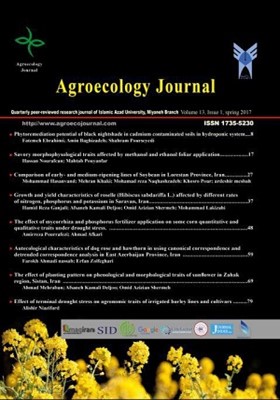The effect of salinity stress on traits related to germination of quinoa (Chenopodium quinoa Willd)
Subject Areas : Agroecology JournalHadi Salek Mearaji 1 , Afshin Tavakoli 2 , Soheila Ghanimati 3 , parvin kasirlou 4
1 - Department of Production Engineering and Plant Genetics, University of Zanjan, Zanjan, Iran
2 - 4Associate Professor, Department of Production Engineering and Plant Genetics, University of Zanjan, Zanjan, Iran.
3 - Department of Production Engineering and Plant Genetics, University of Zanjan, Zanjan, Iran
4 - student
Keywords: Seed", " Stress" , "Germinationpercent", " Germinationrate", " Salinitylevel" "Chenopodiumquinoa",
Abstract :
Salinity is one of the most abiotic stress that cased reduce the yield of crops. Quinoa has role importance in human nutrition and have a high resistance to salinity stress. In order to investigate the effects of salinity stress on germination characteristics of quinoa cultivar Q26, experiment was conducted based a complete randomized design (CRD) with four replication. The treatments consisted of different concentrations of sodium chloride (NaCl) (0, 4, 8, 12, 16, 20, 30 and 40 dS/m) on the germination seed of quinoa under laboratory conditions. Salinity have undesirable effects on traits study such as germination percentage, germination rate, shoot and root length, shoot and root dry weight, stem-to-root ratio (Coefficient of Allometry), germination uniformity and time to 50 percent germination. The percent germination significantly reduce in 30 dS/m salinity, but many traits reduced in concentration 40 dS/m of NaCl. The percentage of germination was not significant between control and 30 dS/m treatment, but at 40 dS/m concentration reduced to 75 percent. With increase salinity levels, time to 50 percent germination increased significantly. Germination rate also reduced significantly by salinity levels. The shoot- to- root ratio decreased with increasing salinity up to 20 dS/m but reached a maximum at 30 dS/m The results showed that quinoa cultivar Q26 has high resistance to salinity stress in germination stage, therefore it can be said that this cultivar have a good resistance to 30 dS/m of sodium chloride and can be the best cultivar for saline condition after field evaluation and appropriate climate.


